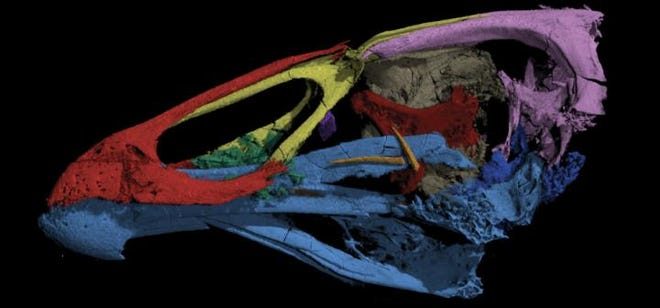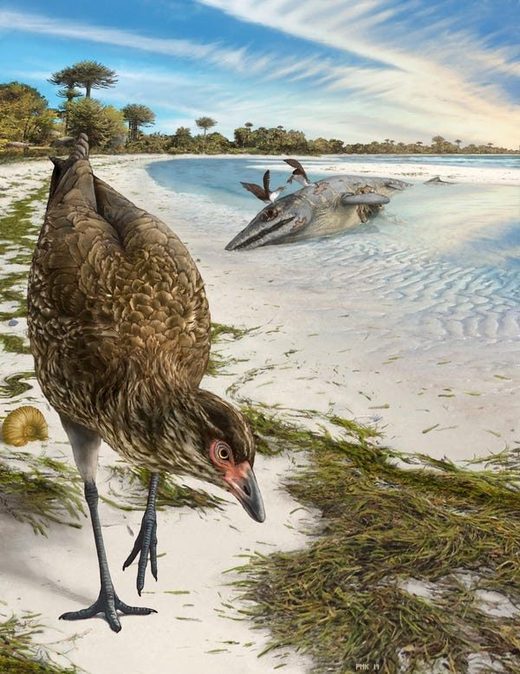
Dubbed the Wonderchicken, the remains were found in rocks dating to about 66.8m to 66.7m years ago, revealing that the bird was active shortly before the asteroid strike that wiped out the dinosaurs 66m years ago.
"This is the oldest evidence of modern birds that we have so far," said Dr Daniel Field, of the University of Cambridge, an avian palaeontologist and co-author of the research.
Modern birds evolved from meat-eating theropod dinosaurs, with creatures such as the 150 million-year-old Archaeopteryx cropping up along the way. In sharp contrast to Archaeopteryx, modern birds have no teeth and tend to lack the bony tails and clawed wings of many of their predecessors.
It is not clear exactly when modern birds emerged, but estimates range from about 110m years to 85-70m years ago.
"As best as we can tell, this fossil sits very close to the common ancestor of two major groups of living birds - the group that eventually gave rise to chickens and their relatives, and the group that eventually gave rise to ducks and their relatives," Field said.
The team says the discovery pushes back the date of the earliest known modern bird: the record was previously held by Vegavis whose fossils were discovered in Antarctica and dated to about 66.5m years ago.
Writing in the journal Nature, Field and colleagues describe making the discovery while carrying out CT scans on a specimen donated to Maastricht Natural History Museum. The fossils were unearthed 20 years ago by an amateur fossil hunter at a quarry in Belgium, near the border with the Netherlands, within sedimentary marine rock that is part of the so-called Maastricht Formation.
At first, said Field, the specimen appeared unprepossessing. "It is basically four small blocks of rock with a handful of broken limb bones visible, poking out of the rock," he said. However, on digitally "removing" the low-density rock around the fossil using computer software, the team found something special.

The team say the bird would have weighed about 400g, about half the size or less of a mallard duck. "It is the same size as a green-winged teal, which is one of the smallest ducks in the entire world," said Field. "We think it would have had a face that looked a little bit like a modern chicken, and the back of the skull looked a little bit more like a living duck," he said. Its long slender legs - together with the rocks it was found in - suggest it may have lived along the shoreline.

"We thought that that was apropos because the fossil is so close in time to the asteroid impact," said Field, adding the Greek myth describes Asteria being transformed into a quail and throwing herself into the ocean to avoid Zeus, features that nod both to the animal and the habitat in which it may have lived.
The team say the fossils not only suggest modern bird evolution was in its early stages when the asteroid struck, but its discovery in Europe opens up debate about whether modern birds emerged in the southern hemisphere, as has previously been proposed.
Prof Julia Clarke, an expert in avian palaeontology and Vegavis from the University of Texas, in Austin, who was not involved in the study, described the find as "fantastic" and said it fitted in well with predictions based on Vegavis.
"Finding this new fossil in Europe is key to understanding a global pattern of extinction and survivorship in the Latest Cretaceous," she said.
Prof Mike Benton, a palaeontologist from the University of Bristol, said the new skull was "gorgeous", adding that previous contenders for the world's oldest duck have been queried, and that fossils hunters have been searching hard for unambiguous members of the modern bird group that definitely lived before the dinosaur mass extinction.
"The new fossil ticks all the boxes," he said.
Reference: Daniel J. Field et al., 'Late Cretaceous neornithine from Europe illuminates the origins of crown birds.' Nature (2020). DOI: 10.1038/s41586-020-2096-0



Reader Comments